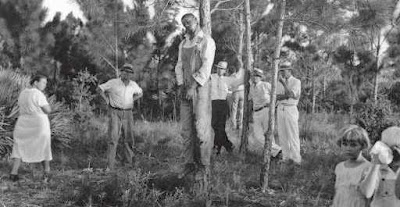
译者:张戟
A Lynching Memorial Unveiled in Duluth
纽约时报
发表时间:二〇〇三年十二月五日
The New York Times
Published: December 5, 2003
国家处理恶梦的方式和人们处理恶梦的方式是一样的--那就是试图忘记他们。在美国,直到最近,在那些公众记忆已经淡忘了的恶梦中,没有比这个国家从1880年至1930年的种族恐怖运动更加的阴森可怕--成千上万的黑人被吊死,被肢解,被活活烧死或拖到死,而大批游人观看。
Nations deal with nightmares the same way people do -- by trying to forget them. Among the nightmares that had faded from public memory in the United States until recently, none are more ghastly than the campaign of racial terror that gripped this country from the 1880's to the 1930's, when thousands of black Americans were hanged, mutilated, burned alive or dragged to death while huge crowds looked on.
这些事件有时也被称为“私刑蜜蜂”或“黑人烤肉”, 是以一种可怕的嘉年华会的形式,吸引人潮带着儿童和野餐的食物,从几英里之外赶来。受害者的尸体被拍照成明信片,作为恐吓工具,直到邮寄这种明信片在20世纪初被禁止。私刑,不是总是偶发的暴力。有时是由白人导演的半官方的暴力,他们担心新兴黑人企业家的商业竞争,和仇视那些黑人记者号召性的报纸,这些报纸在第一次世界大战前后开始紧迫而积极地为黑人争取全部的公民权。
Sometimes called ''lynching bees'' or ''Negro barbecues,'' these events were cast as macabre carnivals, which drew crowds with children and picnic baskets from miles around. The victims' bodies were sometimes photographed for postcards, which were used as instruments of terror until mailing such postcards was barred in the early 20th century. Lynching was not always just random violence. It was sometimes semiofficial violence, directed by whites who feared business competition from emerging black entrepreneurs and who hated the crusading newspapers of the Negro press, which began pressing aggressively for full citizenship for black people around World War I.
知道这段期间这种暴力的美国人,倾向于认为这只局限于种族隔离的南部。但事实上,这种私刑发生在该国许多地方。最近在明尼苏达州北部城市德卢斯市推出的移动纪念馆强调了这种暴力的普遍性,这个纪念馆用以纪念在这期间死亡的三名年轻的黑人男子,埃尔默-杰克逊,埃利亚斯-克莱顿和以扫-麦克基,他们的私刑是在1920年的德卢斯,有10000名暴徒观看。
Americans who know of the violence of this period at all tend to believe that it was confined to the segregationist South. But the fact that lynchings took place in many parts of the country was underscored recently in the northern Minnesota city of Duluth when the city unveiled a moving memorial commemorating the deaths of Elmer Jackson, Elias Clayton and Isaac McGhie, three young black men who were lynched in Duluth in 1920 while a mob of 10,000 looked on.
这个纪念馆吸引了全国各地成千上万的人。激情的高潮来自华伦-雷德的演讲,雷德先生是华盛顿州的一位四年级的老师,他在研究家族史时发现他的高曾祖父曾协助领导那些冲进当地监狱的暴民,并把那三名黑人男子从各自的牢房里带走,这三位黑人男子原是马戏班的工人。他的声音哽咽感慨,他向死难者和他们的家人道歉。
The dedication drew thousands of people from all over the area. The emotional high point came with a speech by Warren Read, a fourth-grade teacher from Kingston, Wash., who had learned while researching his family that his great-grandfather had helped lead the mob that stormed the local jail and took the three men, who were circus workers, from their cells. His voice choking with emotion, he apologized to the victims and their families.
在德卢斯的纪念馆是开始于20世纪90年代民族之旅的一部分,学者们和众多的博物馆开始揭开一个可耻的和可怕的时期的遮羞布。经过近一个半世纪的转折,这个国家现在似乎作好了准备来正视自己那段不堪回首的噩梦。
The memorial in Duluth is part of a national journey that began in the 1990's, when scholars and museums began to pull back the covers on a shameful and horrific period. After nearly a half-century of turning away, the country now seems more ready to look its nightmare squarely in the eye.
1935 lynching of Rubin Stacy in Fort Lauderdale, Florida
湖边草亭
(C)Copyright Reserved
正文
私刑纪念馆在德卢斯揭幕
评论
博主已隐藏评论
博主已关闭评论




